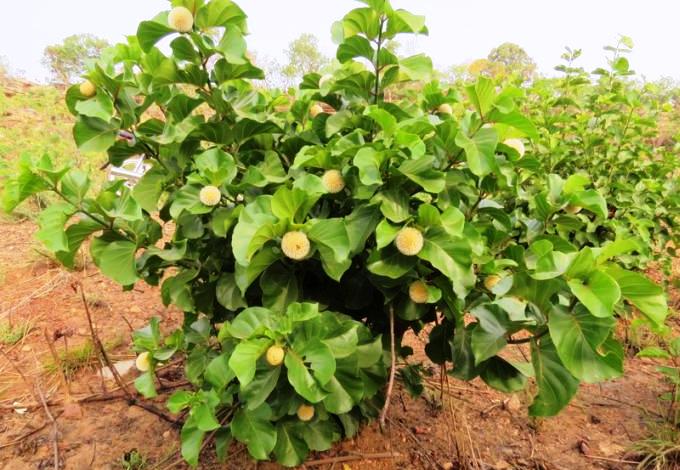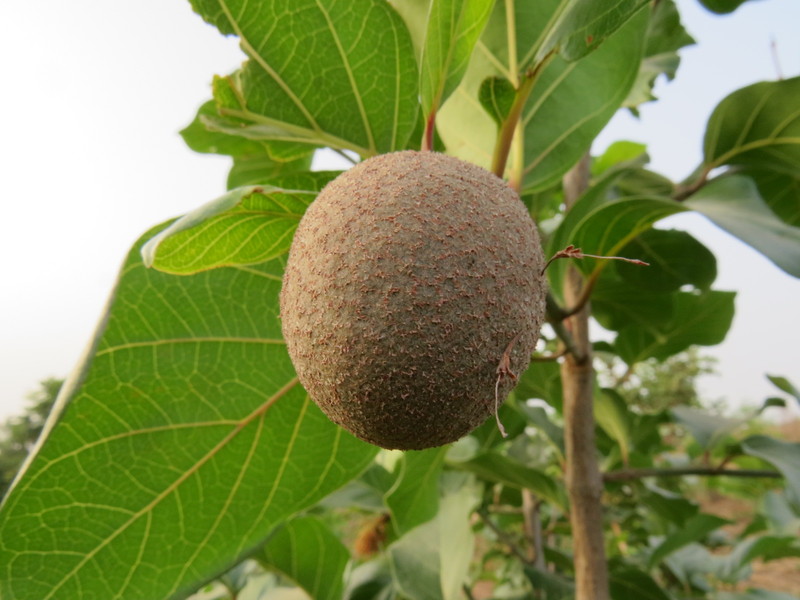Sarcocephalus latifolius (Sm.) E.A Bruce
| Botanical Name | Sarcocephalus latifolius (Sm.) E.A Bruce |
| Order: | Gentianales |
| Family: | Rubiaceae |
| Genus: | Sarcocephalus |
| Species: | S. latifolius |
| Common Names: | African peach; Guinea peach; Country fig; Negro peach |
Plant Synonyms
Sarcocephalus esculentus Afzel. ex Sabine; Sarcocephalus sambucinus K. Schum.; Nauclea latifolia Sm, Nauclea esculenta (Afzel. ex Sabine) Merrile; Sarcocephalus sassandrae A. Chev.; Sarcocephalus russeggeri Kotschy ex Schweinf
Plant Local Names
Burkina Faso: Dagaari - Anguma, Fulfulde - Bakulehi, Grusi - Dianlo
Cote d'lvoire: Adyukru - Edik, Akye - Esubo Monleuh Sibo, Anyi - Balimbe Sibo Tere Gambia: Fula - Dundake, Mandinka - Bakaba, Ba-Tio, Wolof - Koba Nandok
Ghana: Adangme - Akabi, Akan - Awintin, Dagbani-Galungun
Guinea Bissau: Balanta - Cunhe Tetugole, Bioyogo - Canhame, Crioulo - Diunk
Mali: Dogo.n - Ayugu, Manding Bambara - Bari
Nigeria: Edo - Aragbaihi, Hausa – Igiyaa Tafaashiyaa, Igbo - Mbiliinu, Yoruba - Egbesi
Senegal: Vulgar - Dundake, Balanta – Batio Feas, Diola Flup - Bundufe
Sierra Leone: Bulom - Gbilgbil-Le, Fula - Dunduke, Gola - Yumbuyamba
Togo: Bassari - Degangande, Ewe – Alo kubasa kaio, Konkomba- Bunangim
Plant Habitat
Common in the guinea savanna; also occurs in grassland savanna.
Plant Material of Interest
Root
Plant Description
A strangling shrub or a small evergreen tree that grows in the savanna woodland up to 9 m high; crooked bole up to 30 cm in diameter; bark rough; leaves elliptic or rounded-ovate, cuneate, rounded or subcordate base, 10-20 cm long, 6-12 cm broad, glabrous, obovate, apex shortly and abruptly acuminate, upper surface darker, petiole red, stipules short, broad, ovate, and more persistent; flowers, pedicel 1-2 cm long; flower- heads white, up to 5 cm in diameter , fragrantly sweet scented, sought by bees, becoming large and fleshy, not drying hard, with reddish fruit, fleshy, comparatively shallow-pitted fruits up to 9 cm in diameter; fruiting season (May-June, Sept.-Oct.), edible, sweetly acid pulp with
Plant Used Parts
Plant Uses
Extracts of the bark, root and leaves are used by natives of West, Central and East Africa for various ailments including sores, gonorrhoea, stomach disorder, cough and fever. The plant is used in Nigerian folk medicine in the treatment of piles and dysentery. An infusion of the bark has been widely used as a tonic and febrifuge, hence the description "African quinine" (Oliver-Bever, 1986). The pulverized root and bark have been used to treat sores and gonorrhoea in Sudan, Ghana, Ivory Coast and Nigeria (Irvine, 1961). Similarly, a decoction of the root bark is commonly employed in the treatment of stomach disorders, cough and malaria fever (Irvine, 1961). The herb has also been reported to be used as a component of arrow poison in Northern Nigeria and Cote d'lvoire.
Plant Therapeutic Action
Antibacterial; antimalarial; antipyretic; cytotoxic; diuretic; febrifuge; stomachic; tonic
Plant Precaution for Use
Do not exceed the recommended doses
Plant Adverse Effect
May delay labour in childbirth
Plant Contraindication
Constipation, uterine inertia, urinary retention, pregnancy
Plant Dosage Forms
Infusion, decoction and tincture
Plant Dosage
250 g macerated in about 600 ml "gin" (local alcoholic beverage) or hot water; 100 ml taken orally two or three times a day depending on the severity of the feverish condition
Tincture; 1:5 in 50% alcohol, 5 ml three times daily.
Plant Storage
Store in a cool dry place
Plant Chromatographic Fingerprint
Analytical TLC on silica gel G60 F254, 0.25 mm layer in petroleum ether (40-60 °C)/chloroform [2:8], detection in daylight, after spraying with anisaldehyde (0.5 ml) mixed with 10 ml glacial acetic acid, 85 ml methanol and 5 ml concentrated sulphuric acid and heated to 100- 110°C for 5-10 min. Presence of four characteristic spots with Rfs 0.47 (pink), 0.37 (pink), 0.19 (pink) and 0.14 (light brown).
Plant Constituents
Tannins, phenols, saponins, terpenes, steroids, reducing sugars; glycoalkaloids and indoloquinolizidine alkaloids (e.g. naucletine, naucleficffne); carbohydrates, resins; bitter principles (GHP, 1992; Oliver-Bever, 1960),. nauclefoline, and nauclechine (Hotellier et al., 1981).
Plant Pictures
Plant References
Akpanabiatu, M.I., Umoh, I.B., Eyong, E.U., Udoh, F.V. (2005). Influence of Nauclea latifolia Leaf Extracts on Some Hepatic Enzymes of Rats Fed on Coconut Oil and Non-Coconut Oil Meals. Pharmaceutical Biology (Formerly International Journal of Pharmacognosy 43(2):153-157.
Amos, S., Abbah, J., Chindo, B., Edmond, I., Binda, L. et al., (2005). Neuropharmacological effects of the aqueous extract of Nauclea latifolia root bark in rats and mice. Journal of Ethnopharmacology 97(1); 53-57.
Deeni, Y., Hussain, H. (1991). Screening for antimicrobial activity and for alkaloids of Nauclea latifolia. Journal of Ethnopharmacology 35:91- 96.
Gidado, A., Ameh, D.A., Atawodi, S.E. (2005). Effect of Nauclea latifolia leaves aqueous extracts on blood glucose levels of normal and alloxan-induced diabetic rats. African Journal of Biotechnology 4(1):91-93. (
Gbeassor, M., Tona, L., Kossou, Y., A'megbo, K., De souza, C. et al. (1989). Antimalarial effects of eight African medicinal plants. Journal of Ethnophamacology 25:115-118.


